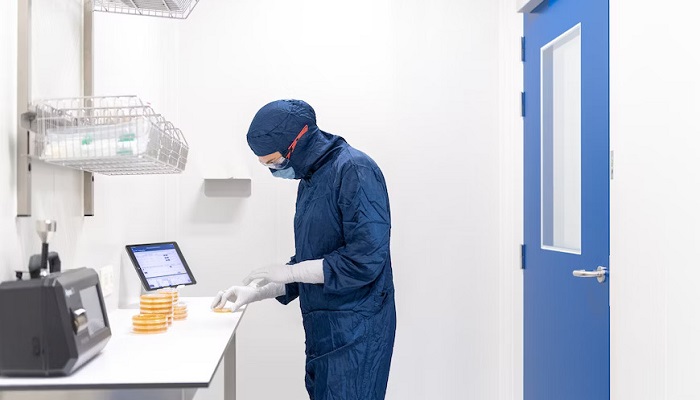Cleanrooms have emerged as an indispensable asset in the realm of pharmaceutical research, significantly impacting the development and production of life-saving medications. These controlled environments, meticulously designed to maintain extremely low levels of airborne contaminants, play a pivotal role in safeguarding the integrity and efficacy of pharmaceutical products.┬Ā
Based on a study conducted by Grand View Research, the worldwide market for cleanroom equipment was worth USD 2.6 billion in 2022. It is anticipated to witness a compound annual growth rate of 6.3% from 2023 to 2030.
As we delve into the evolving landscape of pharmaceutical research, it becomes evident that cleanrooms are shaping the future of this critical industry. In this article, we will explore the crucial role of cleanrooms in the pharmaceutical industry.┬Ā
The Crucial Role of Cleanrooms
Cleanrooms form the bedrock of pharmaceutical research facilities. They provide the ideal setting for scientists and researchers to conduct experiments, develop new drugs, and study potential therapies. These sterile environments minimize the risk of product contamination, ensuring that the medications under investigation are not compromised during testing and development.┬Ā
In cleanrooms, meticulously maintained air quality and stringent particle control measures significantly reduce the chances of cross-contamination, leading to more reliable and accurate results. As pharmaceutical research continues to push the boundaries of innovation, cleanrooms will remain pivotal in maintaining the highest standards of quality and safety.
Precision and Consistency in Drug Manufacturing
According to a post by American Cleanroom Systems, the pharmaceutical industry is governed by strict regulations. CGMP (Current Good Manufacturing Practice) and GMP (Good Manufacturing Practice) are the cornerstones of drug production. CGMP and GMP both emphasize the critical need for maintaining stringent cleanliness and quality control measures throughout the manufacturing process.┬Ā
Cleanrooms serve as the controlled environment where these guidelines come to life, providing optimal conditions for pharmaceutical researchers and manufacturers to work with precision and confidence. With cGMP vs. GMP, the distinction lies in the focus of their requirements. While both CGMP and GMP aim to ensure the highest standards of product quality, safety, and efficacy, they have slightly different scopes and applications.
cGMP specifically targets the current best practices in pharmaceutical manufacturing. It continually evolves with advancements in science and technology, adapting to the latest innovations and discoveries. Conversely, GMP provides a broader framework of quality assurance guidelines applicable to various industries, including food, medical devices, and cosmetics, in addition to pharmaceuticals.
Advancements in Biotechnology
As biotechnology continues to drive the development of novel therapies, cleanrooms have become an essential component in harnessing the potential of cutting-edge research. In the realm of biopharmaceuticals, which includes biologics and gene therapies, sterile environments are non-negotiable.┬Ā
Cleanrooms enable the cultivation of delicate cell cultures and the manipulation of genetic material without the risk of contamination. The precision and sterility maintained within these controlled spaces empower scientists to explore groundbreaking therapies that target diseases at their core, revolutionizing patient care.
Expediting Drug Development Timelines
The process of drug development is a time-consuming endeavor, often spanning several years from initial research to regulatory approval. According to an article by biostock.se, the typical duration from the initial discovery phase to reaching the market averages around 12 years. Cleanrooms accelerate this timeline by providing a controlled environment that accelerates testing, analysis, and production stages.┬Ā
With the minimized risk of contamination and the ability to work with highly sensitive compounds, researchers can progress through various developmental phases more efficiently. The increased pace of drug development means that life-changing medications can reach patients faster, addressing critical medical needs more promptly.
Mitigating Healthcare Challenges
Cleanrooms play a vital role in addressing healthcare challenges, particularly during outbreaks or pandemics. In the face of infectious diseases, such as the COVID-19 pandemic, rapid research and drug development are essential.┬Ā
According to a post on Med-Tech Innovation, cleanrooms have reinforced their crucial role during the pandemic. Cleanrooms provide the secure environment needed to handle highly contagious agents while conducting research and producing vaccines and treatments. By speeding up the response to emergent health crises, cleanrooms contribute significantly to safeguarding global public health.
Pioneering Personalized Medicine
As the pharmaceutical landscape shifts towards personalized medicine, cleanrooms are instrumental in crafting tailored treatments for individual patients. These controlled environments enable researchers to work with patient-specific materials without the risk of contamination or errors.┬Ā
With the potential to create custom-made medications based on a patient’s genetic makeup and unique needs, cleanrooms open new avenues for precision medicine. This offers hope for more effective therapies and better patient outcomes.
Final Thoughts
Cleanrooms have become indispensable in pharmaceutical research, propelling drug development and manufacturing with precision and sterility. As the pharmaceutical industry evolves, cleanrooms play a pivotal role in maintaining the highest standards of product quality and safety.┬Ā
They accelerate drug development timelines, addressing critical medical needs more promptly. Furthermore, cleanrooms contribute significantly to public health by swiftly responding to healthcare challenges and outbreaks.┬Ā
Their role in advancing biotechnology and enabling personalized medicine opens new possibilities for groundbreaking therapies, enhancing patient care and outcomes. Embracing cleanrooms as essential assets is key to shaping the future of pharmaceutical research and revolutionizing global healthcare.


















